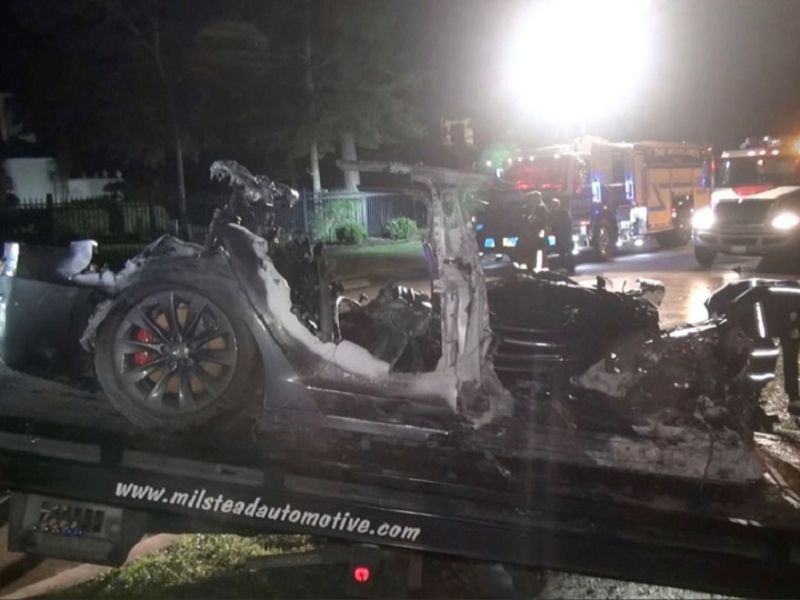
The fiery crash of a Tesla sedan that killed two people in Texas earlier this month involved a front-end collision that caused extensive damage and may have ignited the car’s powerful battery cells, according to a local fire authority’s report.
The report provides more clues to the April 17 incident involving a gray 2019 Model S that hit a tree and caught fire in The Woodlands, a wealthy neighborhood in greater Houston. Tesla is working with the National Highway Traffic Safety Administration and the National Transportation Safety Board, two U.S. agencies that are probing the bizarre crash.
The vehicle sustained “a significant front-end collision” that may have damaged the battery, power distribution system, or battery-temperature control systems, causing the lithium-ion cells in the Tesla to ignite, according to the Harris County Fire Marshal’s Office.
The fire was caused by the collision, investigator Chris Johnson concluded, ruling out factors not specifically related to the crash — although he was unable to determine the first heat source.
Tesla’s vice president of vehicle engineering, Lars Moravy, said Monday on an earnings call that the company found the steering wheel of the vehicle to be “deformed, leading to the likelihood that someone was in the driver’s seat at the time of the crash.”
The company didn’t have an immediate comment on the report. It’s cooperating with investigators.
Police with the Harris County Precinct 4 Constable’s Office initially said that “no one” was in the driver’s seat, which led to speculation that the vehicle’s Autopilot technology may have been a factor. CEO Elon Musk took to Twitter to refute that notion.
The NTSB is working to publish as soon as possible a preliminary report on the crash, a senior official said, acknowledging public confusion over the fatal accident.
“A preliminary report typically comes out in a month, but we are working hard to get it out as soon as possible because we recognize there is this confusion out there,” Kristin Poland, deputy director at the NTSB, said in an interview. “The sooner we can get out the preliminary report out the better it will be for everybody to provide as much clarity as possible,” she said, saying the report will be based on solid facts.
The NTSB has criticized Tesla’s Autopilot after a series of investigations into fatal crashes, including a lack of adequate driver monitoring systems.
William Varner, 59, and Everette Talbot, 69, were both found dead when first responders arrived on scene. Talbot was seated in the right front passenger seat with his upper torso “in a forward-leaning position, with both arms rolled forward.” Varner was seated in the left rear passenger seat with his upper torso “in a rear-leaning position, with both arms rolled back and in a pugilistic pose.”
There were signs of “extensive mechanical damage” and a “large debris field” of exterior trim parts and mechanical components was found to the west of the car, the report stated. It didn’t specify the vehicle’s speed on impact or whether airbags and seat belts were used and deployed.
The “front left wheel appeared to have separated from the suspension/steering assembly and folded inward toward the engine compartment,” and the tire was melted from the heat, the report said. “The front right wheel separated from the vehicle entirely.”
Reuters contributed to this report.